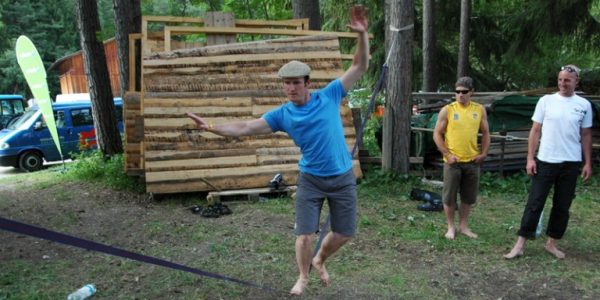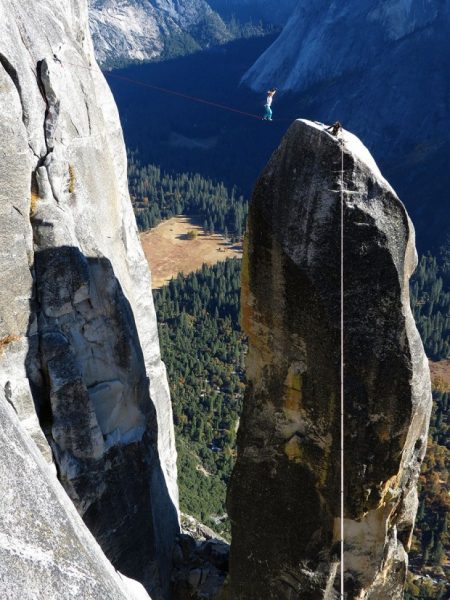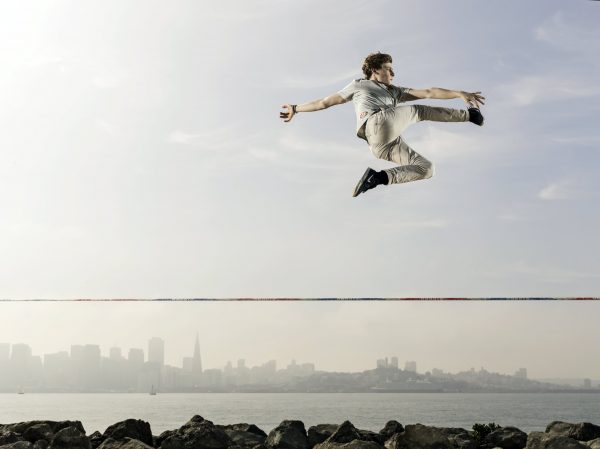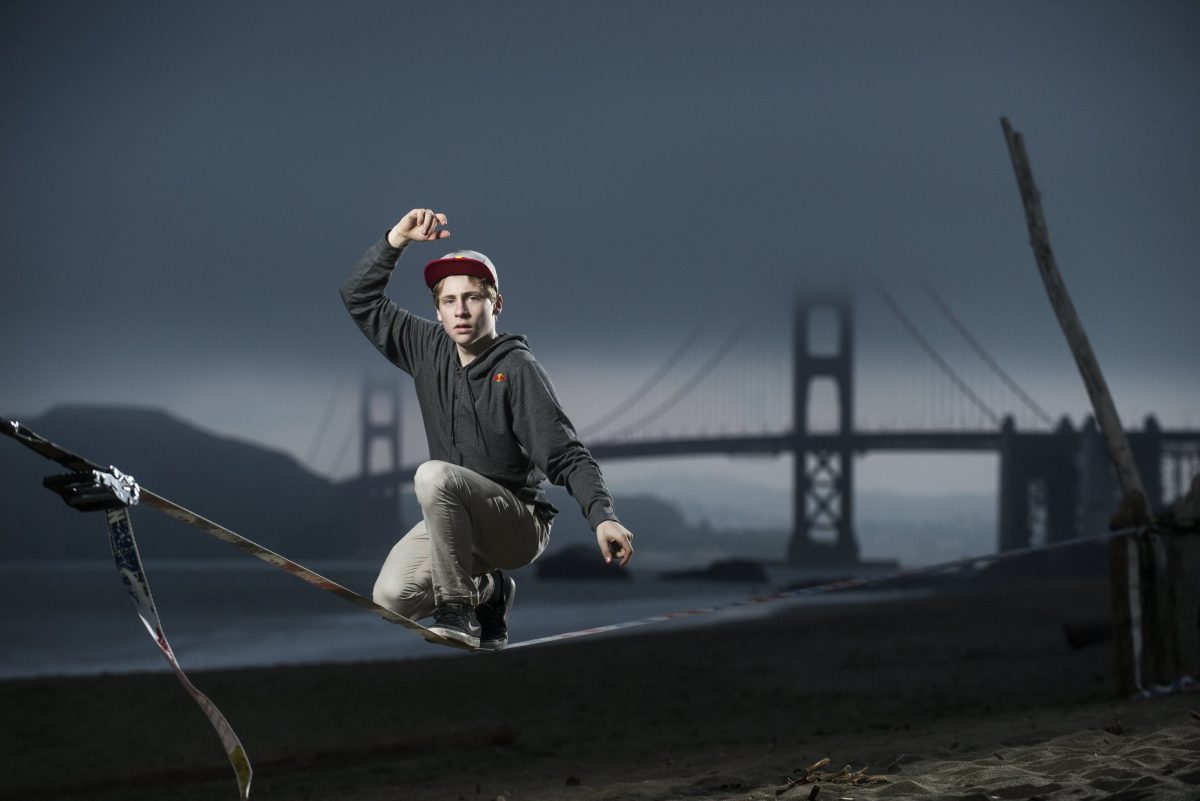Slacklining: from Yosemite to a backyard garden
While Michael Jackson sang “I’m gonna rock with you…”, somewhere in the depths of the California Valley, balking climbers-dirtbags on the verge of social acceptance-began their adventure with a completely different kind of rocking. Probably also to the rhythm of completely different music.
 80s. Today’s famous climbers on the summit of El Capitan, Yosemite, in the 1930s (fot. adventuresportsjournal.com / arch. Russ Walling)
80s. Today’s famous climbers on the summit of El Capitan, Yosemite, in the 1930s (fot. adventuresportsjournal.com / arch. Russ Walling)
History
After an initial period of trials on steel cables, climbing ropes and chains surrounding parking lots in Yosemite National Park, in the early 1980s. Adam Grosowsky i Jeff Ellington – considered the fathers of slacklining – for the first time used a wide tubular tape. It turned out to be a hit – balancing on the wider tape created much more possibilities.
It is worth noting at this point that slackline is a completely separate field from the art of tightrope walking, which was already known in ancient times. Rope walking, which inspired Adam and Jeff, uses a highly taut rope (usually steel) and a pole to help maintain balance.
 Larry Zulim balancing on a steel chain in the Valley, late 1970s. In the 1970s (photo. Georg Meyers)
Larry Zulim balancing on a steel chain in the Valley, late 1970s. In the 1970s (photo. Georg Meyers)
The first webbing that American climbers stretched between two trees was 2.5 centimeters wide, which is about the width of today’s webbing used for walking (the webbing for performing evolutions, known as “slacklining”). trickline, are wider). Climbers whose lives focused exclusively on activities in the Valley quickly made progress.
 Adam Grosowsky and Jeff Ellington in the Valley, in the early 1980′ (photo. slackrobats.com)
Adam Grosowsky and Jeff Ellington in the Valley, in the early 1980′ (photo. slackrobats.com)
As early as the summer of 1983. Adam and Jeff have hung the first-ever highline (the equivalent of a sklackline with the slight difference that it is very high above the ground). Measuring just under 17 meters, the tape led to the Lost Arrow Spire. The originators of the project did not manage to pass the entire slack – although today the distance itself may not arouse admiration, back then it was a huge challenge. As if not Lost Arrow Spire Highline became one of the most famous highline’s in the world.
It happened partly because of its historical significance, and partly because of the unique (for such a short distance) space stretching out under the slackliners’ feet – the tape is suspended 880 meters above the valley floor.
In 1985. Scott Balcom He is the first to pass the famous tape:
This is a work of art. I managed to turn this beautiful idea into a beautiful experience.
As it turned out later, it was the beginning of a new era – more and more bold, ambitious and beautiful ideas.
In 2013. our compatriot, Jan Galek, passed Lost Arrow Spire Highline in free solo style, that is, without belay. Footage of this feat and more information about this outstanding slackliner can be found in an article published on climbing.en.
That same year, the first Polish female ascent (with belay) was made by a woman Barbara Sobanska.
 Barbara Sobanska on the Lost Arrow Spire Highline (photo. climbing.pl)
Barbara Sobanska on the Lost Arrow Spire Highline (photo. climbing.pl)
Development of slacklining in the US in the 1980s. spread to the rest of Europe in the 1990s., to finally, with the beginning of the new millennium, reach Poland. In 2006, the country hosted the first competition in this discipline. Since then, slackline has been growing in popularity.
Varieties of slackline
Over the years, walking on a “loose tape” has developed in several directions:
- Longline – A basic variation of the discipline of traversing as long a tape as possible strung between two points (usually trees) relatively low to the ground.
- Highline – The premise is similar to the above, with the main difference being that the tape is high above the ground. Passages are usually made with a belay (a special lunge connecting the slackliner to the tape), although there is no shortage of daredevils passing the highline tapes in the so-called “high line”. free solo style – no belay. An interesting variant of the highline is the spaceline, which is three or more straps connected at a central point – this configuration is even more unstable and creates the impression of going not to a specific point, but into the void.
- Trickline – a spectacular variation of slacklining involving not walking, as in previous cases, but jumping and performing evolutions. Special, wider and more resilient tapes are used here.
- Rodeoline – extremely loose webbing, allows you to “surf,” i.e. swing from side to side.
- Waterline – slacklining over water.
Why you should try it?
Regardless of the variety, slacklining offers a unique experience, and is an excellent physical workout – including as a complement to the main activity (climbing, running, skiing). It is an exercise that develops the coordination of the whole body and the sense of balance. Walking on the tape requires concentration, making it a form of movement meditation for some, in addition to relaxation and fun. Today even yoga is practiced on slackline tapes.
 Trickline in urban space (photo. Dustin Snipes / Red Bull Content Pool)
Trickline in urban space (photo. Dustin Snipes / Red Bull Content Pool)
How to get started?
Advice for beginners is provided especially for OM by a slackline specialist – Wojciech Sienko. You can find the guide HERE.


